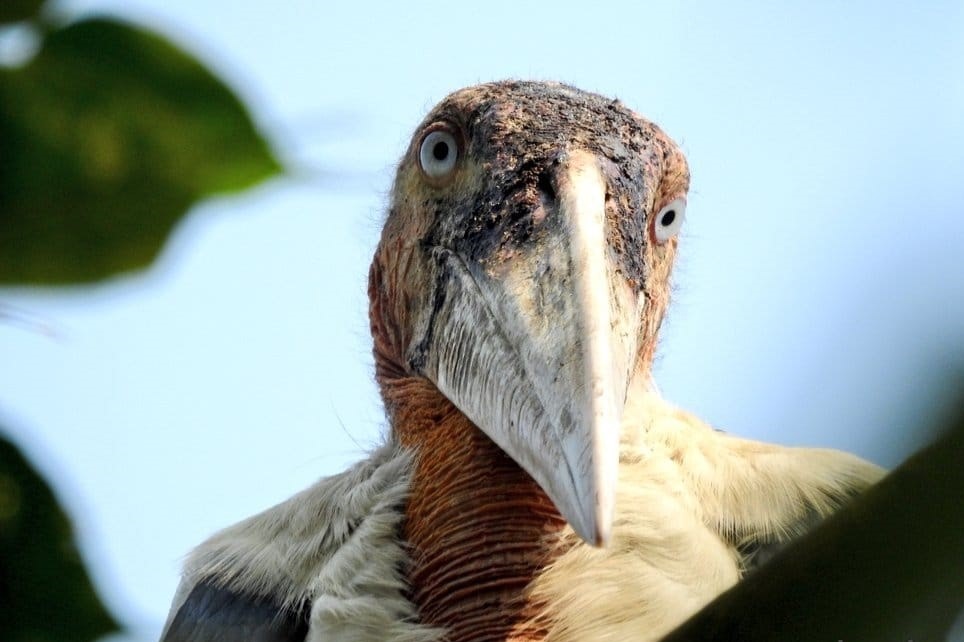
The protection of the species from intensive campaign for building awareness among locals to daily monitoring by saviours in the Kadwa floodplain area of Bhagalpur has scripted success, writes Deepanwita Gita Niyogi
When Bihar’s birdman Arvind Mishra found a handful of nests belonging to the Greater adjutant stork, popularly called the garuda locally, in Bhagalpur district around 2006, he was delighted. Just two years before this, he had come to know of the Lesser adjutant stork in Purnea, another district of Bihar.
As the Greater adjutant is an endangered species, Mishra was determined to protect it. He started an intense campaign in the Kadwa diyara (floodplain) area of Bhagalpur where the bird is found apart from Assam and Cambodia. “It was a tough job initially as the area was not safe and had no easy access. But the locals were motivated to protect the bird when informed about its importance. When I started working, Kadwa lacked roads. At that time only 16 nests were found.”
The remarkable conservation journey has been possible thanks to constant vigil by garur saviours and garur guardians, who are local residents working voluntarily to conserve the Greater adjutant.
One such saviour is Rajeev Kumar who has been working since 2006 on garuda conservation. He is based in Kadwa which lies near the Kosi river bank and where many birds are found. “People like me monitor the nests. There are over 100 nests now. If the birds fall from trees or become ill, they are attended to quickly.”
Protecting the Garuda
Conservation work is on to save the Greater adjutant stork in Bhagalpur ever since Mishra found the nests. Santosh Kumar has been working for a decade now on a voluntary basis towards this cause. To earn his livelihood, he offers private tuition to students.
Both the garuda saviours had no idea about the importance of the bird till Mishra arrived on the scene. “He urged all of us to protect the Greater adjutant. Now, there are over 100 nests. Arjun, semal and bargad trees are preferred for nests. If they fall ill, I take care of them.” There is a committee comprising about 20 such saviours in Kadwa.
Monitoring is not the only thing. To protect the birds, a high tension wire has been laid underground in the area. The birds used to die because of the wire, said bird guide and wildlife enthusiast Ashutosh Kumar. He also informed that apart from the saviours, a few members of the Srishti Ganga Prahri Environment and Welfare Society, a non-profit, is also looking into conservation of the bird.

In order to treat sick and injured birds, the forest department manages the Greater adjutant rescue centre, the only one in the world, in Bhagalpur. To protect the birds, nets have been installed in the Kadwa diyara area which is the natural breeding zone of the Greater adjutant to save them. The population of Greater adjutants in the world is around 1600.
“The forest department conducts a survey every year. At present, there are 600 birds in Bhagalpur. The saviours and guardians were pressed into service by Arvind Mishra who first discovered the birds in 2006 here. He has worked with the community since then,” said Bhagalpur divisional forest officer Bharat Chintapalli.
Already some 40 to 80 people are working towards conservation. Still, when the department gets a call, a rescue team is sent to the spot. Efforts have borne fruits. The bird population has increased from about 75 in 2006 to the current 600.
Conservation journey in Bihar
Apart from electric wires, pesticides pose a threat to the birds. The dominant crops in the area are paddy, wheat and maize. The high-tension electric wire was, however, a recent thing. Mishra recalled when he first found the birds in Bhagalpur, there was no power connectivity in the area.
But poaching was common. “Locals weren’t concerned and poachers used to kill the birds and steal eggs from the nests. When we informed them that it is a rare bird they were convinced. Rapport building took time over tea and meetings. I associated conservation with religion too,” the bird man added.
Bird conservation is not a new thing in Bihar as there have been attempts made from time to time. Chintapalli said in 2001, the forest department conducted a bird site development programme for a month in Bhagalpur as part of which people were trained as bird guides. Some are still continuing while others are into new jobs now. A few of them were from Kadwa.
The forest officer also recalled the first state bird festival of Bihar organised in Jamui district, a Naxal hotbed. It was called Kalrav. Today, visitors can visit the Naginakti bird sanctuary in Jamui where 180 species of birds have been documented. It is a wetland.
Conservation and the fight to protect an endangered species aren’t easy. Mishra did not give up. At one time he had spotted a Greater adjutant on sand bars. “They were juveniles. We monitored the nests but they were dismantled.”But his search continued and he found the nests in Kadwa.












